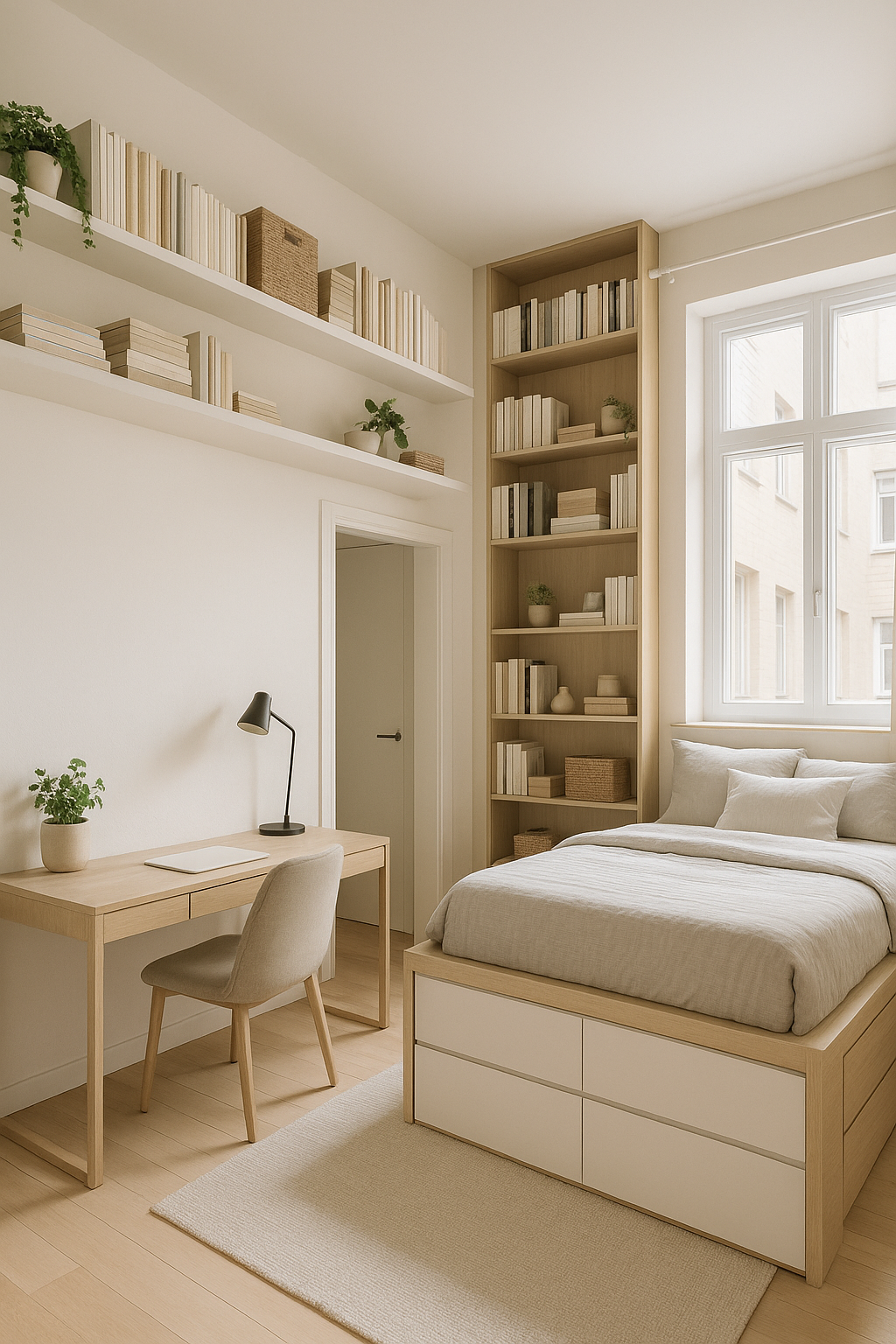When living or working in a small apartment, every inch matters—and that includes the space above your head. Most people overlook the vertical zone between their furniture and the ceiling, but this overhead space can be transformed into functional, beautiful storage and design elements.
In this article, you’ll learn how to maximize overhead space in your home office or compact apartment, turning empty air into opportunities for organization, style, and efficiency.
1. Start by Identifying “Dead Zones”
Walk through your space and look up. Look for areas with:
- Blank wall above eye level
- High ceilings or awkward corners
- Space above doors, windows, or cabinets
- Empty space above your desk or wardrobe
These are prime spots for installing shelves, racks, or other smart storage solutions.
2. Install High Floating Shelves
One of the easiest ways to use overhead space is by installing floating shelves high on your walls.
Ideal spots:
- Above your desk for books or decor
- Over your bed for extra storage
- In the hallway for out-of-season items
- In the kitchen for cookware or pantry containers
Keep a stool or small ladder nearby if you store things you use regularly.
3. Create a Wall-to-Wall Storage Ledge
This is especially effective in rooms with tall ceilings.
How:
- Install a long shelf across the top of one wall
- Store baskets, bins, or books on top
- Add a strip of LED lighting below for ambiance
This setup is great for studios, bedrooms, or hybrid living/working areas.
4. Use Vertical Bookcases or Tower Units
Instead of wide furniture that eats floor space, go tall and narrow.
Options:
- Tower cabinets that reach almost to the ceiling
- Narrow bookshelves or cubby towers
- Modular stacking cubes
Make use of those top shelves for items you use less frequently—just remember to anchor tall furniture to the wall for safety.
5. Add Storage Above Doors and Windows
The wall space above doorways and windows is often ignored—but it’s perfect for compact shelving.
Great for:
- Lightweight boxes or baskets
- Displaying books or decorative objects
- Hiding small electronics or modem/router gear
Keep items light and label baskets to avoid visual clutter.
6. Use Ceiling-Mounted Storage Solutions
Especially useful in kitchens, closets, or laundry areas, ceiling-mounted options include:
- Pot racks for pans or utensils
- Hanging rails for baskets or bins
- Overhead hooks for tools or reusable bags
Make sure to install with secure anchors, especially if you’re hanging heavy items.
7. Incorporate Lofted Furniture
If your ceilings allow, lofting part of your furniture frees up space below—and creates overhead utility above.
Try:
- Lofted beds with desks, storage, or a reading nook underneath
- Raised platforms with drawers or storage cubbies built in
- DIY storage “mezzanines” in studios or high-ceiling lofts
This setup maximizes vertical volume, especially in open-concept spaces.
8. Add Hanging Wall Racks
These are perfect for:
- Home offices: Hanging file organizers or supply caddies
- Kitchens: Hanging spice racks or cooking utensils
- Entryways: Wall hooks for coats, bags, or accessories
Use wood, metal, or mesh depending on your style.
9. Use Tall Cabinets with Ladder Access
If your space allows, install or repurpose tall cabinets and add a small rolling ladder or foldable step stool.
This brings in a boutique, high-end touch and creates a library-style solution to storage challenges.
10. Take Advantage of Closet Top Space
If you have built-in closets, chances are there’s wasted space above them.
Use it to store:
- Labeled boxes with seasonal clothing or decor
- Bulk supplies (toilet paper, office materials, etc.)
- Large but light items like yoga mats or bedding
Use uniform containers and add labels for easy identification.
11. Add a Pegboard or Grid Above Your Desk
Instead of using shelf space for supplies, hang your tools above your desk.
What to store:
- Scissors, rulers, notebooks
- Charging cords, headphones
- Sticky notes, office tools
Paint the board to match your wall or contrast for visual interest.
12. Mount a Drop-Down or Fold-Up Desk
If you’re short on workspace and storage, combine both.
Ideas:
- A wall-mounted desk that folds up into a cabinet
- A shelf-desk combo that opens into a full surface
- A Murphy desk with vertical shelving inside
Great for small studios or bedrooms used as home offices.
13. Decorate with Overhead Features
Not all overhead space has to be purely functional—it can also enhance your visual design.
Ideas:
- Hang plants from the ceiling in macramé holders
- Use pendant lights instead of floor lamps
- Install ceiling-mounted curtain rods to divide spaces
These features add vertical interest without using floor area.
14. Be Mindful of Balance and Safety
Too much overhead storage can feel heavy or claustrophobic if not handled carefully.
Tips:
- Keep heavier items lower, lighter items up high
- Stick to neutral baskets or uniform bins to reduce visual clutter
- Use anchors and wall studs for secure mounting
- Avoid placing storage directly over your bed or seating zones
Always test weight limits before loading shelves or racks.
15. Rotate Contents Seasonally
Overhead space is perfect for items you don’t use every day.
Store up high:
- Seasonal office supplies or decor
- Gift wrap, holiday items, or archived documents
- Extra bedding, luggage, or hobby gear
Create a system to rotate items out seasonally, keeping your lower storage zones for high-use essentials.
Overhead space is an often-overlooked goldmine in small apartments and home offices. By thinking vertically, you can transform blank walls, ceiling zones, and high corners into useful and beautiful storage.
Whether you install floating shelves, loft your bed, or simply add a shelf above your doorway, small changes can have a huge impact. Use your space smartly, and let every level of your home work hard for you.

